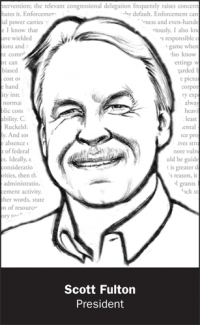With all the challenges that humanity faces, there are huge opportunities as well.
Which is not to say that the environmental news isn’t bleak. When the world community met in Bonn last November to advance the Paris Agreement on climate change, Washington signaled it would be leaving the 2015 accord and abandoning the key domestic program for achieving America’s commitment to reduce its greenhouse gas emissions by 26-28 percent over the next dozen years, the Clean Power Plan to cut power plant emissions. But despite the new administration’s actions, the momentum behind America’s Paris pledge remains strong — and emissions reductions in general continue across the world, as 190-plus other nations move to implement the agreement.
On the downside, we face profound challenges not only at the national level with the new administration, where the pullback from environmental regulation has been well documented, but also at the state level, where budget crises are taking a toll. For example, the Connecticut Department of Energy and Environmental Protection (which I led from 2011 to 2014) faces dramatic budget cuts and staff reductions. And the CT Green Bank, which I helped to launch — bringing Republicans and Democrats together to use limited clean energy resources to leverage private capital — faces budget challenges too.
These pressures require us to pursue our environmental agenda in new and better ways. For instance, one of the most profound points of learning from ecological science over the last fifty years is that we must take a systems approach to environmental problems. Air, water, waste, and land use are all connected. Issues at the global, national, state, and local levels are all connected. Thus, we need to use the current crisis to shape a 21st century policy strategy that is more integrated and better captures the opportunities from systems thinking.
The logic of connectedness extends to the political domain. Yet, our elected officials appear more deeply divided than ever. Clean energy can move on a bipartisan basis, but it takes hard work, it takes compromise, and it takes doing things in better ways, not simply reiterating the same old arguments that have kept people apart for so very long.
While a systems approach can and should be deployed across the environmental agenda, climate change looms as the central — even existential — challenge of our times, demanding worldwide collaboration and, at the same time, transformative change toward a clean energy future at the local, state, and national levels. As a young EPA official, I helped to negotiate the 1992 Framework Convention on Climate Change. Maurice Strong, the Canadian diplomat and businessman who chaired the 1992 Rio Earth Summit at which the convention was launched, took me aside and said, “Dan, you’ve got to remember, that when we gather all these presidents and prime ministers, only two outcomes are possible: Success and real success.” Sadly, we have not delivered real success over the ensuing 25 years. Emissions have continued to rise, and we have not transformed the energy foundation for our planet.
The 1992 climate treaty was top-down, reflecting the prevailing wisdom that national governments were the way to deliver transformative change and broad-based outcomes. In contrast, the Paris Agreement shifts toward bottom-up strategies that recognize the reality that presidents and prime ministers don’t actually control most of the decisions that determine the carbon footprints of their societies. Those decisions — about urban development, transportation, housing, and economic activity — fall more directly to mayors, governors, CEOs, university presidents, and the leaders of community organizations. The Paris accord, with its more decentralized structure, reflects the fact that they are the ones who make the actual decisions that will determine whether our society decarbonizes.
The importance of this shift in focus cannot be over-stated. Since the 1648 Treaty of Westphalia, national governments have been in charge. But what was the right structure to solve the religious wars of Europe in the 17th century might not be right for solving 21st century environmental problems. We are not one nation with one leader in one place. We have a much richer tapestry of political and societal leadership. California Governor Jerry Brown, for instance, leads a sovereign state with great potential to deliver greenhouse gas emissions reductions. Likewise dozens of other governors, mayors, and corporate leaders have committed their states, cities, and companies to climate action — thus keeping momentum behind the Paris Agreement.
I argue that this new broader leadership framework should be formally acknowledged and celebrated. In this regard, I would like to see the Paris Agreement opened to signature by mayors, governors, CEOs, and others who are steering society toward a transformed energy future. This same logic would apply, I might add, to all future global agreements where national governments alone cannot deliver successful outcomes.
More generally the game plan of the 1992 framework convention, reflecting 20th century thinking, centered on targets and timetables for emissions reductions. I call this “the lawyer’s mistake,” since those with legal training often think that if you pass a law, write regulations, sign a treaty, or issue rules, people will follow them. No one in business would have made that mistake. They would regard the treaty as a mission statement or maybe a business plan, but lacking a serious implementation strategy. The Paris Agreement gets beyond this error, shifting people’s focus from mere goals to incentives to deliver solutions — particularly new strategies for financing investments in energy efficiency and renewable power infrastructure. And it moves away from a command-and-control model that demands conformity to a single path forward to an approach that asks each country to say what it can do and how it will do it.
To that end, there is no better incentive to reduce emissions and expand the deployment of wind, solar, and other renewable power sources than to make people pay for the harm they cause — thus steering them toward clean energy options. In this spirit, many countries (and companies — and even universities) have begun to put carbon charges in place. Using price signals stands in contrast with the 20th century strategy of regulatory mandates, which require the government to figure out all the answers — and then tell business what to do. But in the 21st century we face a broad-based problem where everyone’s behavior has to change, not just large businesses but the myriad of small businesses and individuals too.
Another contrast with the 20th century is that we now live in the Information Age and have a variety of Big Data and communications tools that did not exist in the past. We can track harms with much greater precision and simultaneously gauge whether our policy interventions are working. Thus, we have the capacity today to measure performance at the national, state, local, and company scales — and to identify leaders, laggards, and best practices. The Paris Agreement reflects this new data opportunity and calls for a “stocktake”every five years to see if the actions being undertaken are delivering at the pace and scale required to mitigate climate change.
With the Paris Agreement, I believe we have turned a corner — and the move toward a decarbonized future is now inevitable. But let me tell you the bad news. The pace of change can be affected by political leadership. President Trump’s push to withdraw the Clean Power Plan will have an impact. Likewise, the administration’s budget cuts and other regulatory changes (including the plan to pull back from using a $40-per-ton “social cost of carbon” in regulatory analyses) will slow the shift toward a clean energy future.
But it will not stop it. Coal is not coming back. Market forces ensure that fact regardless of regulatory changes. And innovation in support of a transformed energy future continues around the world — with or without the United States. While I disagree with much of what the administration is doing, it must be said that the Clean Air Act isn’t the best vehicle for addressing climate change. Simply put, it doesn’t provide a ready way to put a price on emissions. In this regard, I would prefer a carbon charge that begins at $5 per ton of carbon dioxide or equivalent and escalates by $5 every year until the carbon charge reaches $100 a ton at year 20. We know that carbon pricing works. In the Northeast, we already pay a $5-per-ton charge through the Regional Greenhouse Gas Initiative — and top-tier clean energy results.
The Clean Power Plan, by contrast, emerged under the old 20th century regulatory model because there was no other possibility available. Congress had signaled that it would not pass comprehensive climate change legislation. So, we ended up with a primitive tool. Within the constraints of the Clean Air Act, the CPP offers considerable flexibility. Each state has been given a target for reducing emissions. Not each power plant, each state. And which states got the hardest assignments? Those who had already done the most. As the commissioner of Connecticut’s Department of Energy and Environmental Protection at the time, I was furious about this structure that assigned the states that had dragged their feet on climate change more lax targets. I then realized the separate standards were politically shrewd. When the challengers from the foot-dragging states go to court, the judges are going to look at them and say, “Really? When other states are already 90 percent decarbonized, why can’t you take the first easy steps?”
While some might see the current political challenges as dire, I think action on climate change will continue apace — even in the United States. For one thing, President Trump is finding out that he cannot erase the CPP with the stroke of a pen. Our law says that once a regulation has been finalized, you have to take it down by the same notice-and-comment process. American administrative law requires that an agency act furthermore in a manner that is neither arbitrary nor capricious. In re-examining the Clean Power Plan, EPA must make a decision based on science and facts. There have to be hearings, citations of relevant studies, and careful review of the administrative record before a judgment can be made that a different policy would better achieve the statutory goals of avoiding emissions that endanger public health and welfare. In addition, Congress and the courts have roles to play. As the administration has already seen, these co-equal branches will not hesitate to act.
Just as governors and mayors are stepping up to the issue of climate change, so too are corporate leaders. In the wake of Trump’s pullback on climate change, the business community has not, by and large, walked back from its commitments to reduce emissions. To the contrary, nearly 2,000 companies have joined the We Are Still In climate coalition. Citizens will also be critical in delivering a sustainable future. People are putting their environmental values into action as consumers — signaling their interest in sustainability by buying green products, such as electric vehicles. Likewise, an ever-wider swath of investors are saying, “I want the companies in my portfolio to align with my values” and therefore are asking for more information on the environmental, social, and governance performance of companies, including details on corporate climate change action plans. I see this trend as continuing, with more and more of us factoring carbon footprints into all kinds of decisions, including how we do our business, how we lead our lives, how we raise our children, and how we engage with our communities.
We have entered an era of sustainability. Not everyone yet recognizes it, but a growing number of people and institutions and businesses have come to accept that we face a sustainability imperative. In this regard, we have to gauge progress not just in terms of economic results but also environmental and social outcomes. Multiple goals that entail inevitable tradeoffs makes policymaking more difficult. With this broader perspective in mind, we can achieve real success on climate change and other challenges, but it will require transformation of our environmental policies — and our politics. TEF






